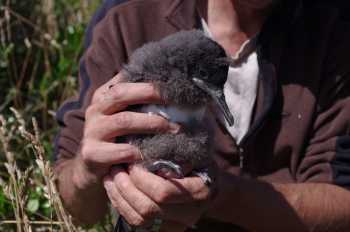A total of 225 Fluttering Shearwater Puffinus gavia chicks was transferred from Long Island across the Cook Strait to the Mana Island Scientific Reserve in New Zealand during 2006-2008. At least 191 chicks (85%) were presumed to have fledged successfully in good enough condition to survive post-fledging (click here).

Fluttering Shearwater chick on Mana Island on 11 January 2012
Photograph by Colin Miskelly
Following the return of some of these birds as adults to Mana Island a single Fluttering Shearwater chick was reared in 2010/11. Seven chicks in burrows occupied by translocated birds should fledge in the latest (2011/12) breeding season following their banding by Colin Miskelly on 11 January. More chicks are likely to have been produced in undetected or unmonitored burrows, some of the latter being on inaccessible cliffs.
In addition to the translocated chicks that have returned as adults, a few unbanded birds have been attracted by loudspeakers broadcasting petrel calls each night, and perhaps also by the birds that have returned to the island (click here for more details).
With thanks to Colin Miskelly, Curator Terrestrial Vertebrates, Museum of New Zealand Te Papa Tongarewa for information and a photograph.
John Cooper, ACAP Information Officer, 26 January 2012

 English
English  Français
Français  Español
Español